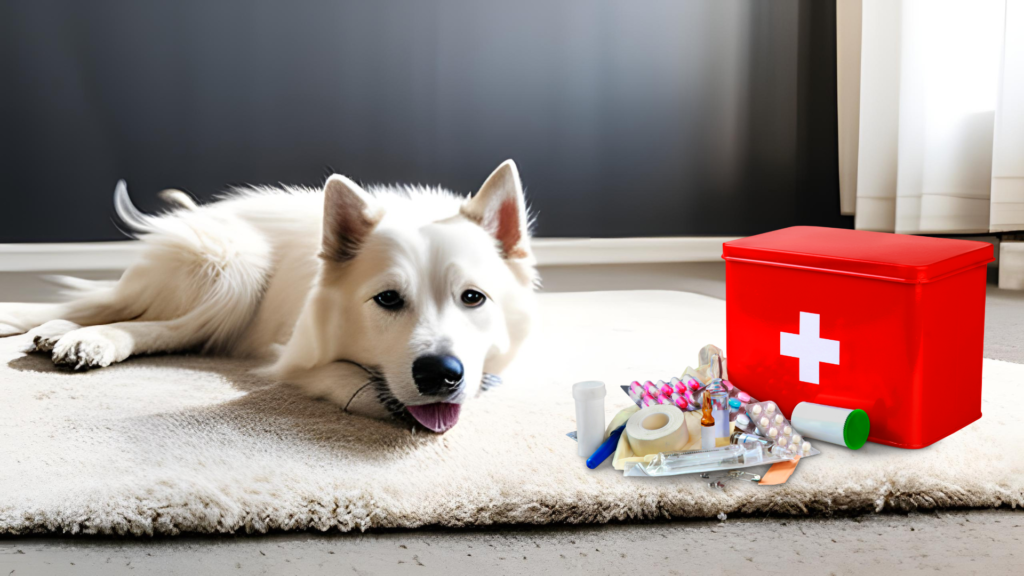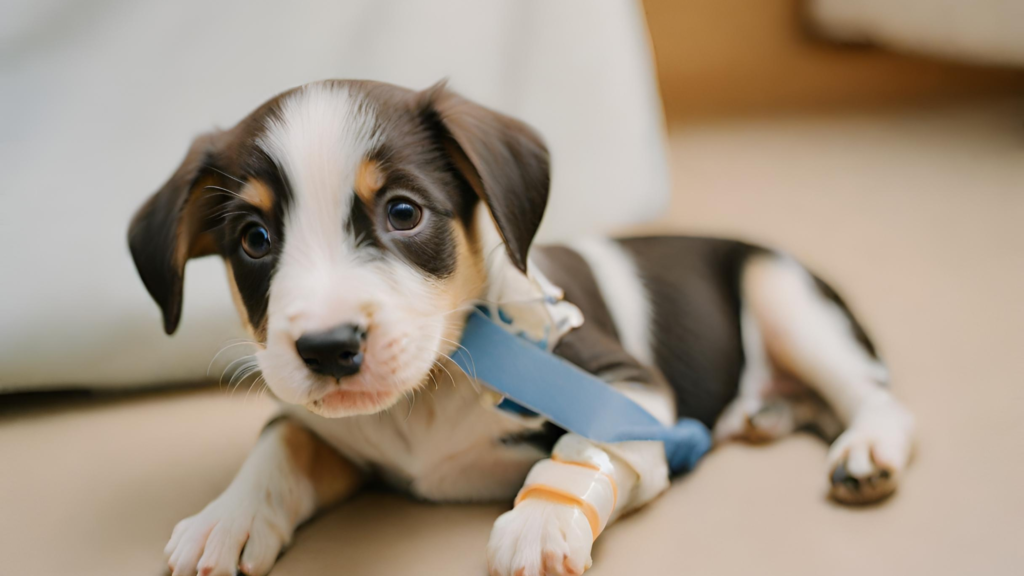Welcoming all dog lovers and responsible pet owners to a vital discussion on canine well-being – “First Aid for Dogs.” Our furry companions bring boundless joy into our lives, yet unforeseen emergencies can arise, putting their health at risk. Picture this: your loyal friend suddenly chokes on a treat, or sustains an unexpected injury during playtime. In these critical moments, having the knowledge and tools for canine first aid can make all the difference.
This blog post aims to empower you with essential skills and insights into handling common emergencies, from choking incidents to potential poisoning risks. We’ll delve into the must-have items for your canine first aid kit, guide you through specific first aid scenarios, and equip you with preventive measures for a proactive approach to your dog’s well-being.
Common Canine Emergencies
With their boundless enthusiasm and curious nature, our dogs can sometimes find themselves in precarious situations. Knowing how to respond to emergencies is key to ensuring their safety and well-being. Let’s explore the most common canine emergencies and equip ourselves with the knowledge needed to act swiftly and effectively.
A. Choking and Breathing Difficulties
Whether it’s due to a hastily consumed toy or a treat, recognizing the subtle cues of choking is crucial. Remember that choking is far more common in dogs than you believe it is.
Recognizing Signs
Watch for pawing at the mouth, excessive drooling, difficulty breathing, or unusual sounds. Breathing difficulties can arise from various causes, including allergies or respiratory issues, presenting signs like wheezing, rapid breathing, or a bluish tint to the gums.
Immediate Response Techniques
For choking incidents, the Heimlich maneuver technique and other immediate responses with calm and precision. In cases of breathing difficulties, assess the situation, keep your dog calm, and seek veterinary assistance promptly. Your ability to navigate both scenarios can be a lifesaver for your beloved companion.
B. Cuts, Wounds, and Bleeding
Dogs, being adventurous by nature, are exposed to various scenarios that may lead to cuts, wounds, and bleeding. Common reasons for these injuries include encounters with sharp objects, thorns, or accidental falls.
Assessing Severity
When your dog returns from an outdoor adventure with a visible cut, understanding the severity of such injuries is vital. Distinguish between minor scratches, which may only require basic care, and more severe wounds demanding immediate attention. Mild cuts may involve superficial skin abrasions, while deeper lacerations, especially those with persistent bleeding, indicate a need for urgent intervention.
For instance, a scraped paw pad may be a mild cut, whereas a deep gash that continues to bleed warrants immediate attention.
Proper Wound Cleaning and Bandaging
In the event of a cut or wound, providing proper care is essential for your dog’s well-being. Follow these step-by-step actions to ensure effective wound cleaning and bandaging:
- Gather Necessary Supplies: Use a clean cloth or gauze to wipe away debris and clean the wound. Ensure you have a mild antiseptic solution for cleaning. Have a supply of sterile bandages appropriate for the size of the wound. Use adhesive tapes or vet wraps to secure the bandage in place.
- Assess the Severity of the Wound: For superficial wounds, gently clean the area with the antiseptic solution. For deep wounds, apply gentle pressure using a clean cloth or gauze to control bleeding before cleaning.
- Clean the Wound: Apply a small amount of the antiseptic solution to a clean cloth or gauze. Clean the wound by wiping away debris and dirt. Be gentle to avoid causing additional trauma.
- Apply Bandage: Place a sterile bandage over the cleaned wound. Use adhesive tape or vet wrap to secure the bandage in place. Ensure it’s snug but not too tight to allow for proper circulation.
- Monitor and Change Bandage as Needed: Monitor the wound for any signs of infection or changes in condition. Change the bandage regularly, especially if it becomes soiled or wet.
Remember, while proper wound care can be administered at home, it’s essential to consult with a veterinarian for professional guidance, especially for more severe wounds or those showing signs of infection.

C. Poisoning
Poisoning in dogs refers to the ingestion of substances that are harmful and potentially life-threatening to them. This can happen through accidental consumption of toxic foods, plants, medications, or household items.
Identifying Common Household Hazards
In our homes, seemingly harmless items can pose a significant poisoning threat to our dogs. Common household hazards include:
- Foods: Chocolate, grapes, onions, and certain artificial sweeteners.
- Plants: Common houseplants like lilies, azaleas, and philodendrons.
- Medications: Over-the-counter and prescription drugs that are accessible to dogs.
- Chemicals: Household cleaners, pesticides, and certain chemicals used in and around the house.
- Small Objects: Items like batteries, rubber bands, and small toys that can be swallowed.
Being aware of these potential dangers is the first step in preventing accidental poisoning incidents.
Steps to Take in Case of Poisoning
If you suspect your dog has ingested a toxic substance, immediate action is crucial. Follow these steps:
- Remain Calm: Stay composed to make rational decisions.
- Identify the Poison: If possible, determine what your dog ingested to provide accurate information to the veterinarian.
- Contact the Veterinarian: Call your veterinarian or an emergency pet poison hotline immediately.
- Do Not Induce Vomiting: In some cases, inducing vomiting can worsen the situation. Follow professional advice.
- Bring the Substance: If safe to do so, bring the product or its packaging to the vet for identification.
- Observe Symptoms: Monitor your dog for symptoms like vomiting, diarrhea, lethargy, or difficulty breathing.
Read the detailed guide at RSPCA
Remember, prompt action can be life-saving. Always keep emergency contact information, including your veterinarian and poison control hotline, readily accessible. Being proactive in both prevention and response is key to safeguarding your dog from poisoning threats.
D. Heatstroke
Heatstroke in dogs occurs when their body temperature rises to dangerous levels, typically above 106°F (41°C). This condition can be life-threatening and requires immediate attention.
Recognizing Symptoms
During hot weather, it’s crucial to recognize the signs of heatstroke in dogs:
- Excessive Panting: Dogs regulate their body temperature through panting, but excessive panting can be a sign of distress.
- Drooling and Salivating: Unusually heavy drooling can indicate overheating.
- Lethargy: A dog in distress may become lethargic or weak.
- Bright Red Gums and Tongue: An indication that the blood vessels are dilating to cool the body.
- Vomiting or Diarrhea: Gastrointestinal symptoms may also occur.
If you observe these symptoms, it’s crucial to act swiftly.
Cooling Measures
In the event of heatstroke, follow these steps systematically:
- Move to a Cool Area: Immediately get your dog to a shaded or air-conditioned space.
- Offer Water: Allow your dog to drink small amounts of cool water.
- Use Cool Compresses: Apply cool, damp towels to your dog’s neck, armpits, and groin areas.
- Avoid Cold Water: Contrary to popular belief, do not use ice-cold water, as it can constrict blood vessels and hinder the cooling process.
- Use a Fan: Increase air circulation around your dog to enhance the cooling effect.
- Monitor Temperature: Regularly check your dog’s rectal temperature, ensuring it gradually returns to normal.
These cooling measures should be implemented promptly, but seeking professional veterinary care is imperative. Heatstroke can escalate rapidly, and immediate intervention is crucial to ensure your dog’s safety and well-being.
Essential First Aid Supplies
Building a canine first aid kit is a proactive step toward ensuring your dog’s well-being. Equip yourself with these essential supplies:
Must-Have Items:
- Gauze Pads and Bandages: Essential for wound care.
- Adhesive Tape and Vet Wrap: Secure bandages and dressings.
- Antiseptic Solution: Clean wounds and prevent infections.
- Scissors and Tweezers: Aid in precise cutting and splinter removal.
- Digital Thermometer: Monitor your dog’s temperature.
- Hydrogen Peroxide: Use under veterinary guidance for induced vomiting.
- Disposable Gloves: Ensure hygiene during first aid procedures.

Storage and Accessibility:
- Compact Container: Keep supplies organized.
- Accessible Location: Store in an easily reachable spot.
- Check Expiry Dates: Regularly update and replace expired items.
This well-prepared kit can be a lifeline in unforeseen situations.
First Aid for Specific Situations
A. Insect Bites and Stings
In the great outdoors, encounters with insects are inevitable. Here’s how to handle insect bites and stings effectively:
Safe Removal of Stingers
- Stay Calm: Keep both yourself and your dog calm to minimize stress.
- Identify the Stinger: Locate the stinger and ensure it’s no longer embedded.
- Use Tweezers or a Credit Card: Gently scrape or tweeze out the stinger without squeezing, reducing venom release.
- Clean the Area: Wash the bite or sting site with mild soap and water.
Managing Allergic Reactions
- Monitor for Signs: Watch for signs of an allergic reaction such as swelling, hives, or difficulty breathing.
- Administer Antihistamine: If your dog has a history of mild reactions, administer a vet-approved antihistamine.
- Seek Veterinary Assistance: In severe cases, or if symptoms worsen, seek immediate veterinary attention.
- Prevent Future Incidents: Identify and avoid areas prone to insect activity during walks or playtime.
By following these steps, you can minimize the impact of insect bites and stings on your dog’s well-being.
B. Fractures and Sprains
Accidents happen, and knowing how to respond to fractures and sprains is crucial for your dog’s welfare:
Stabilization Techniques
- Assess the Situation: Gauge the severity of the injury and your dog’s pain level.
- Muzzle Your Dog: Even the gentlest dogs may bite when in pain; use a makeshift muzzle to ensure safety.
- Stabilize the Limb: For fractures, splint the injured limb with a rigid material (e.g., cardboard or rolled newspaper).
- Apply a Bandage: Secure the splint with a bandage, being cautious not to make it too tight.
- Keep Dog Calm: Limit movement and keep your dog as calm as possible to prevent further injury.

Transporting Injured Dogs
- Use a Stretcher or Blanket: For large dogs, use a sturdy board or blanket as a makeshift stretcher.
- Lift with Care: Lift your dog gently and evenly, avoiding sudden movements.
- Secure in the Vehicle: Ensure your dog is safely and comfortably secured during transport.
- Notify the Vet: Call ahead to alert the veterinarian, providing details for immediate attention upon arrival.
Mastering these steps empowers you to be a calm and effective first responder, enhancing your dog’s chances of a smooth recovery from fractures and sprains.
When to Seek Professional Help?
Understanding the limitations of first aid is crucial for responsible pet care. While first aid can address immediate concerns, it does not replace professional veterinary care. Some situations, such as severe injuries or complex medical conditions, necessitate the expertise of a veterinarian. Knowing when first aid is insufficient ensures your dog receives comprehensive and timely care.
In cases of emergencies or when uncertain about a situation, swift communication with a veterinarian or emergency services is paramount. Have contact numbers readily accessible. If your dog exhibits severe symptoms or experiences an accident, don’t hesitate to seek professional guidance. Quick action enhances the chances of a positive outcome and minimizes potential complications.
Preparing for vet visits involves more than scheduling appointments. Organize your dog’s medical records, including vaccination history and any ongoing treatments. Create a calm travel routine to reduce stress. This proactive approach ensures that vet visits are efficient and beneficial, contributing to your dog’s overall well-being.
Preventive Measures
Dog-Proofing the Home Environment:
- Keep household cleaners, medications, and small objects out of reach.
- Ensure your home is free from plants that could be harmful if ingested.
- Redirect chewing behavior toward safe toys to prevent damage to furniture and potential ingestion of harmful materials.
Regular Veterinary Check-ups:
- Ensure your dog undergoes regular veterinary check-ups, promoting early detection of potential health issues.
- Stay up-to-date with vaccinations and administer preventive treatments for parasites, such as fleas and ticks.
Canine CPR and Training:
- Learn and practice basic canine CPR techniques, including chest compressions and rescue breathing.
- Attend canine first aid and CPR training sessions to enhance your ability to respond effectively in emergencies.
- Develop an emergency response plan, including contact information for your veterinarian and nearby emergency veterinary services.
Implementing these preventive measures ensures a safe and thriving environment for your dog, minimizing the risk of emergencies and promoting their overall well-being.
Conclusion
In the journey through “First Aid for Dogs,” you’ve become the vigilant guardian every canine companion deserves. From mastering the art of recognizing signs of emergencies to assembling a canine first aid kit stocked with essentials, you’re now equipped to navigate unexpected challenges with confidence. Whether addressing insect bites or stabilizing fractures, your proactive approach ensures swift and effective care.
Understanding the limitations of first aid, you’ve learned when to seek professional help and how to prepare for vet visits. Implementing preventive measures, from dog-proofing your home to embracing canine CPR training, establishes a safe haven for your furry friend.
As you envision a future filled with joy and shared adventures, remember that being a responsible dog owner is an ongoing commitment. With your newfound knowledge, you’re not just a pet owner – you’re a dedicated advocate for your dog’s health and happiness. Here’s to many more years of laughter, love, and well-cared-for tail wags.
This asset is phenomenal. The wonderful information exhibits the proprietor’s earnestness. I’m stunned and anticipate more such astonishing sections.
Thank You! I really hope I can keep up with writing more about what I love!
This is an amazing page. The outstanding information reveals the owner’s accountability. I’m in awe and eagerly await more amazing postings like this one.
Thank You! Your motivation and kind words will keep me writing more
Can you be more specific about the content of your article? After reading it, I still have some doubts. Hope you can help me.
Certainly! I’d be happy to provide clarification on any specific points you’re unsure about. Could you please let me know which parts of the article are still unclear to you or where you have doubts? That way, I can offer more targeted assistance and ensure that your questions are fully addressed. Thank you for reaching out!